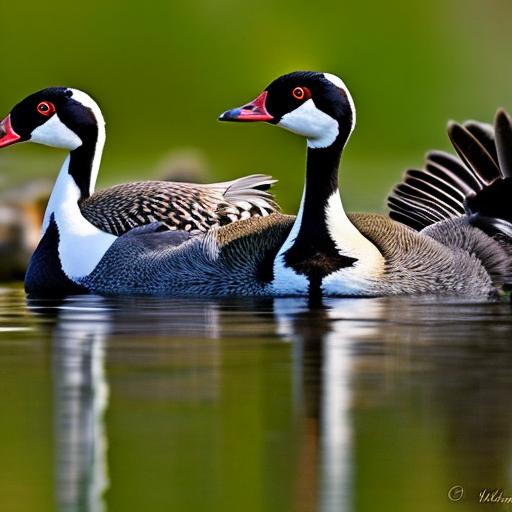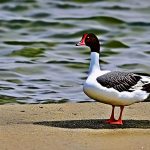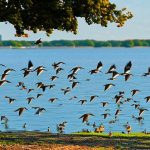Canada geese are known for their strong family bonds and their tendency to return to the same nesting and feeding grounds year after year. Understanding their behavior is crucial in effectively managing their presence. These geese are herbivores and are attracted to open grassy areas near water, making golf courses, parks, and lawns prime locations for them to forage. They are also highly territorial during the nesting season, which typically lasts from March to June. During this time, they can become aggressive towards humans and other animals if they feel their nesting area is threatened. Additionally, Canada geese are highly adaptable and can become accustomed to human presence, making it difficult to deter them from certain areas.
Canada geese are also known for their migratory patterns, with some populations migrating thousands of miles each year. Understanding these patterns can help in predicting when and where the geese will be present, allowing for better management strategies. By understanding the behavior of Canada geese, it becomes easier to implement effective management techniques that take into account their natural tendencies and habits.
Canada geese are known for their strong family bonds and their tendency to return to the same nesting and feeding grounds year after year. Understanding their behavior is crucial in effectively managing their presence. These geese are herbivores and are attracted to open grassy areas near water, making golf courses, parks, and lawns prime locations for them to forage. They are also highly territorial during the nesting season, which typically lasts from March to June. During this time, they can become aggressive towards humans and other animals if they feel their nesting area is threatened. Additionally, Canada geese are highly adaptable and can become accustomed to human presence, making it difficult to deter them from certain areas.
Canada geese are also known for their migratory patterns, with some populations migrating thousands of miles each year. Understanding these patterns can help in predicting when and where the geese will be present, allowing for better management strategies. By understanding the behavior of Canada geese, it becomes easier to implement effective management techniques that take into account their natural tendencies and habits.
Key Takeaways
- Canada geese are territorial and can become aggressive during nesting season
- Physical barriers like fences and netting can prevent geese from accessing certain areas
- Repellents like taste aversions and visual deterrents can discourage geese from staying in an area
- Modifying the landscape by adding vegetation or altering water features can make an area less attractive to geese
- Removing attractants like food sources and nesting materials can discourage geese from staying in an area
- Seek professional help from wildlife management experts for long-term and humane solutions
- Respect wildlife regulations and obtain necessary permits before implementing any control measures
Implementing Physical Barriers
One effective way to manage Canada geese is by implementing physical barriers that prevent them from accessing certain areas. This can include installing fences or netting around bodies of water or open grassy areas where the geese tend to congregate. These barriers can help deter the geese from entering these spaces, reducing the likelihood of damage to property or aggressive behavior towards humans.
Another physical barrier that can be effective in managing Canada geese is the use of visual deterrents such as scarecrows or predator decoys. These visual deterrents can create a sense of danger for the geese, causing them to avoid the area altogether. Additionally, using lasers or other light-based deterrents can also be effective in deterring Canada geese from congregating in certain areas.
Implementing physical barriers is an important aspect of managing Canada geese, as it can help prevent damage to property and reduce the risk of aggressive behavior towards humans. By understanding the behavior of Canada geese and implementing physical barriers that take into account their natural tendencies, it becomes easier to effectively manage their presence.
Using Repellents and Deterrents
In addition to physical barriers, using repellents and deterrents can also be an effective way to manage Canada geese. There are a variety of repellents available on the market that can be used to discourage geese from congregating in certain areas. These repellents can include chemical sprays or granules that create an unpleasant taste or smell for the geese, causing them to avoid the area.
Another effective deterrent for managing Canada geese is the use of sound-based repellents such as propane cannons or sonic devices. These devices emit loud noises that create a sense of danger for the geese, causing them to avoid the area altogether. Additionally, using motion-activated sprinklers or other water-based deterrents can also be effective in deterring Canada geese from congregating in certain areas.
Using repellents and deterrents is an important aspect of managing Canada geese, as it can help prevent damage to property and reduce the risk of aggressive behavior towards humans. By understanding the behavior of Canada geese and using repellents and deterrents that take into account their natural tendencies, it becomes easier to effectively manage their presence.
Modifying the Landscape
Modifying the landscape can also be an effective way to manage Canada geese. This can include altering the terrain around bodies of water or open grassy areas where the geese tend to congregate. For example, creating steep banks around bodies of water can make it difficult for the geese to access these areas, reducing the likelihood of damage to property or aggressive behavior towards humans.
Another way to modify the landscape is by planting vegetation that is unattractive to Canada geese. This can include tall grasses or shrubs that create an inhospitable environment for the geese, causing them to seek out more suitable feeding and nesting grounds. Additionally, creating barriers such as hedges or other natural obstacles can also be effective in deterring Canada geese from congregating in certain areas.
Modifying the landscape is an important aspect of managing Canada geese, as it can help prevent damage to property and reduce the risk of aggressive behavior towards humans. By understanding the behavior of Canada geese and modifying the landscape in ways that take into account their natural tendencies, it becomes easier to effectively manage their presence.
Removing Attractants
Another important aspect of managing Canada geese is removing attractants that draw them to certain areas. This can include removing sources of food such as grass clippings or spilled birdseed that may attract the geese to open grassy areas. Additionally, removing sources of water such as standing puddles or leaky irrigation systems can also help deter Canada geese from congregating in certain areas.
Another way to remove attractants is by cleaning up nesting materials such as feathers or down that may attract Canada geese to certain areas. By removing these materials, it becomes less likely that the geese will choose these areas for nesting, reducing the likelihood of damage to property or aggressive behavior towards humans.
Removing attractants is an important aspect of managing Canada geese, as it can help prevent damage to property and reduce the risk of aggressive behavior towards humans. By understanding the behavior of Canada geese and removing attractants that take into account their natural tendencies, it becomes easier to effectively manage their presence.
Seeking Professional Help

In some cases, managing Canada geese may require seeking professional help from wildlife management experts. These experts have experience in dealing with wildlife management issues and can provide valuable insight into effective management strategies for Canada geese. They can also help assess the situation and develop a customized management plan that takes into account the specific needs of the property and the behavior of the geese.
Professional help may also involve implementing more advanced management techniques such as habitat modification or population control measures. These measures may include egg addling or nest destruction to reduce the number of new goslings being born each year, helping to control the overall population of Canada geese in a given area.
Seeking professional help is an important aspect of managing Canada geese, especially in cases where traditional management techniques have proven ineffective. By working with wildlife management experts who understand the behavior of Canada geese and have experience in implementing effective management strategies, it becomes easier to effectively manage their presence.
Respecting Wildlife Regulations
When managing Canada geese, it is important to respect wildlife regulations and guidelines set forth by local authorities. These regulations are in place to protect both wildlife and human populations and must be adhered to when implementing management strategies for Canada geese.
Respecting wildlife regulations may involve obtaining permits or permissions before implementing certain management techniques such as egg addling or nest destruction. It may also involve working with local wildlife authorities to develop a management plan that is in line with existing regulations and guidelines.
By respecting wildlife regulations, it becomes possible to effectively manage Canada geese while ensuring that all management techniques are carried out in a legal and ethical manner. This not only helps protect both wildlife and human populations but also ensures that management efforts are sustainable in the long term.
If you’re looking for ways to keep Canada geese out of your yard, you may also be interested in learning about creating a secure and comfortable space for your backyard chickens. Check out this informative article on how to build a garden chicken coop to ensure the safety and well-being of your feathered friends while keeping unwanted visitors at bay.
Meet Walter, the feathered-friend fanatic of Florida! Nestled in the sunshine state, Walter struts through life with his feathered companions, clucking his way to happiness. With a coop that’s fancier than a five-star hotel, he’s the Don Juan of the chicken world. When he’s not teaching his hens to do the cha-cha, you’ll find him in a heated debate with his prized rooster, Sir Clucks-a-Lot. Walter’s poultry passion is no yolk; he’s the sunny-side-up guy you never knew you needed in your flock of friends!







